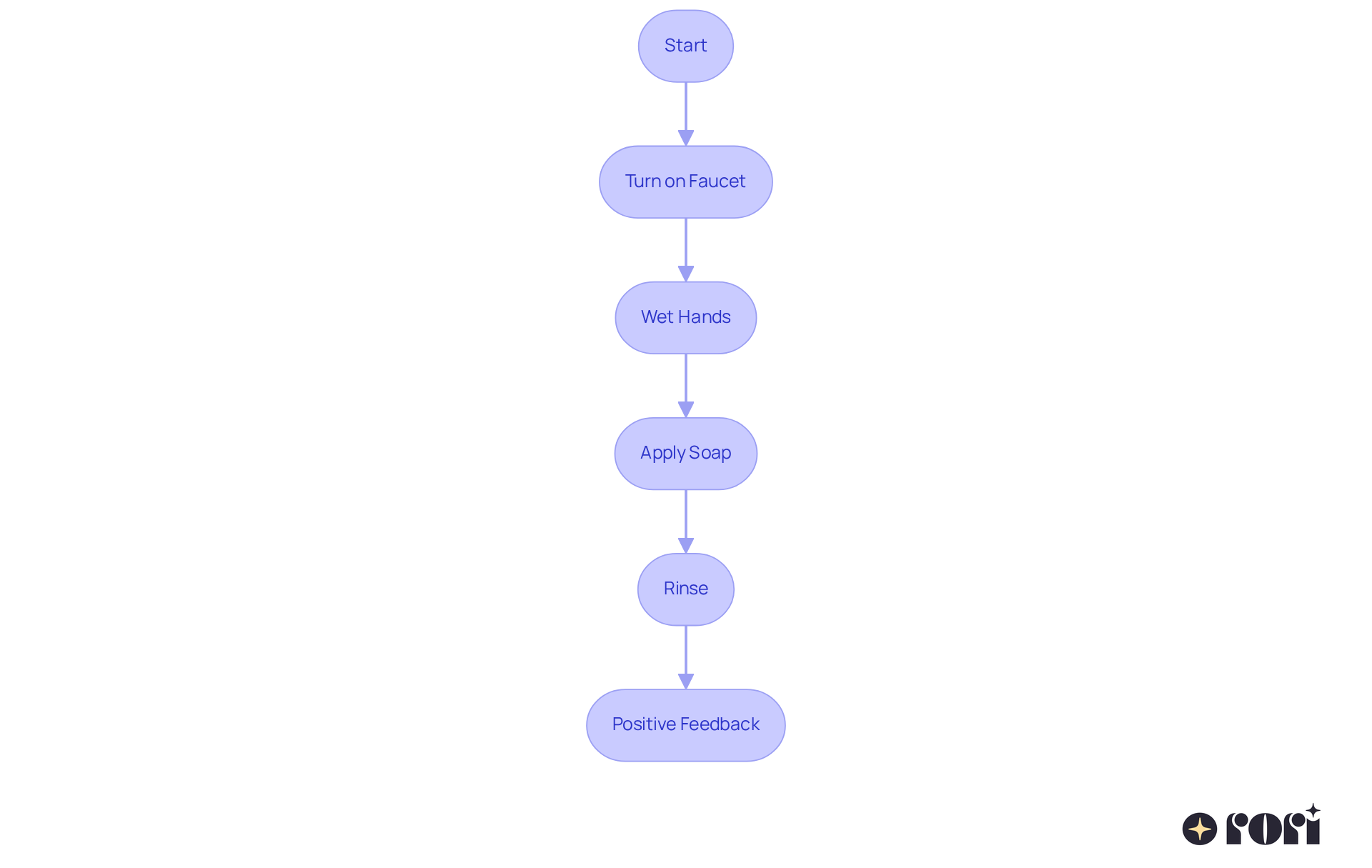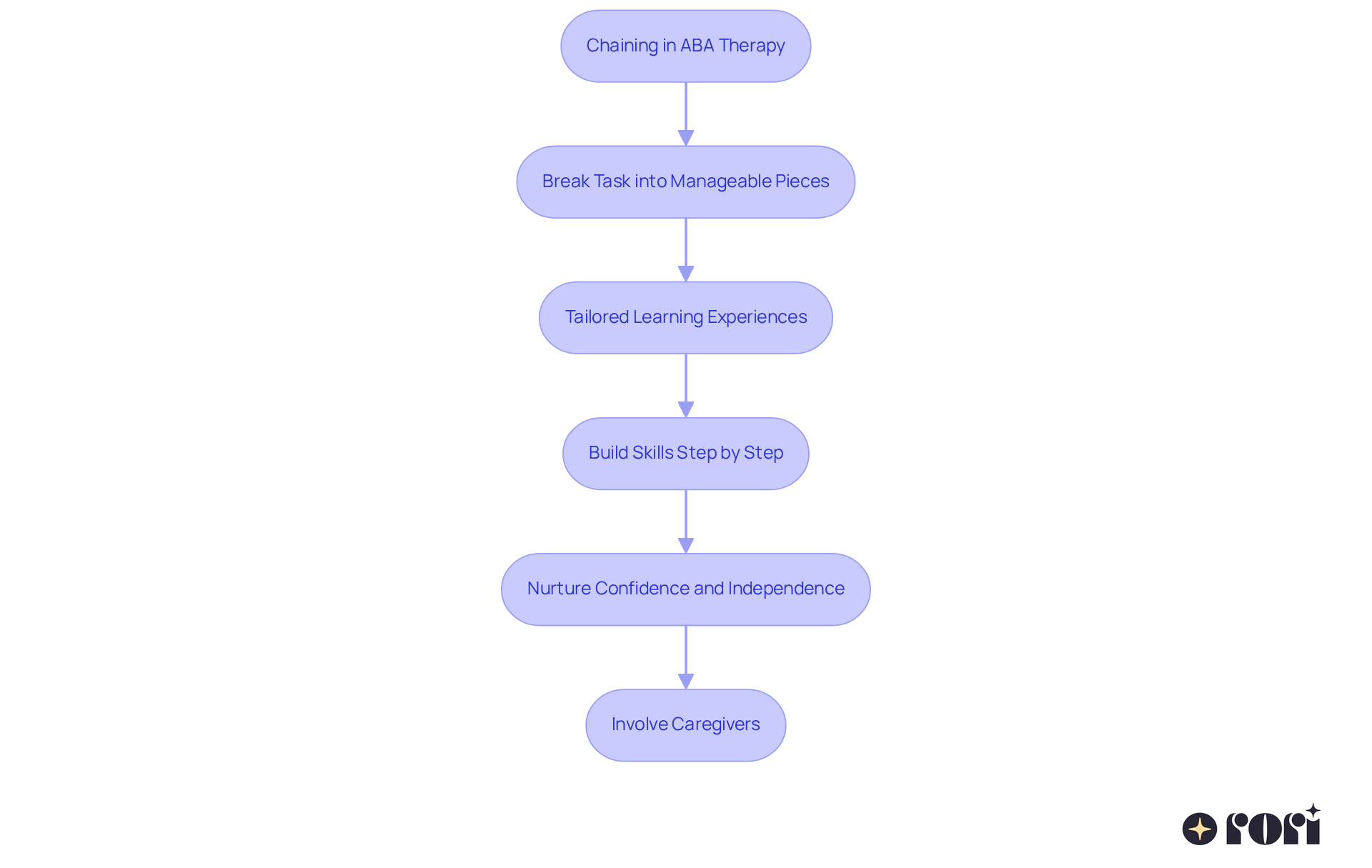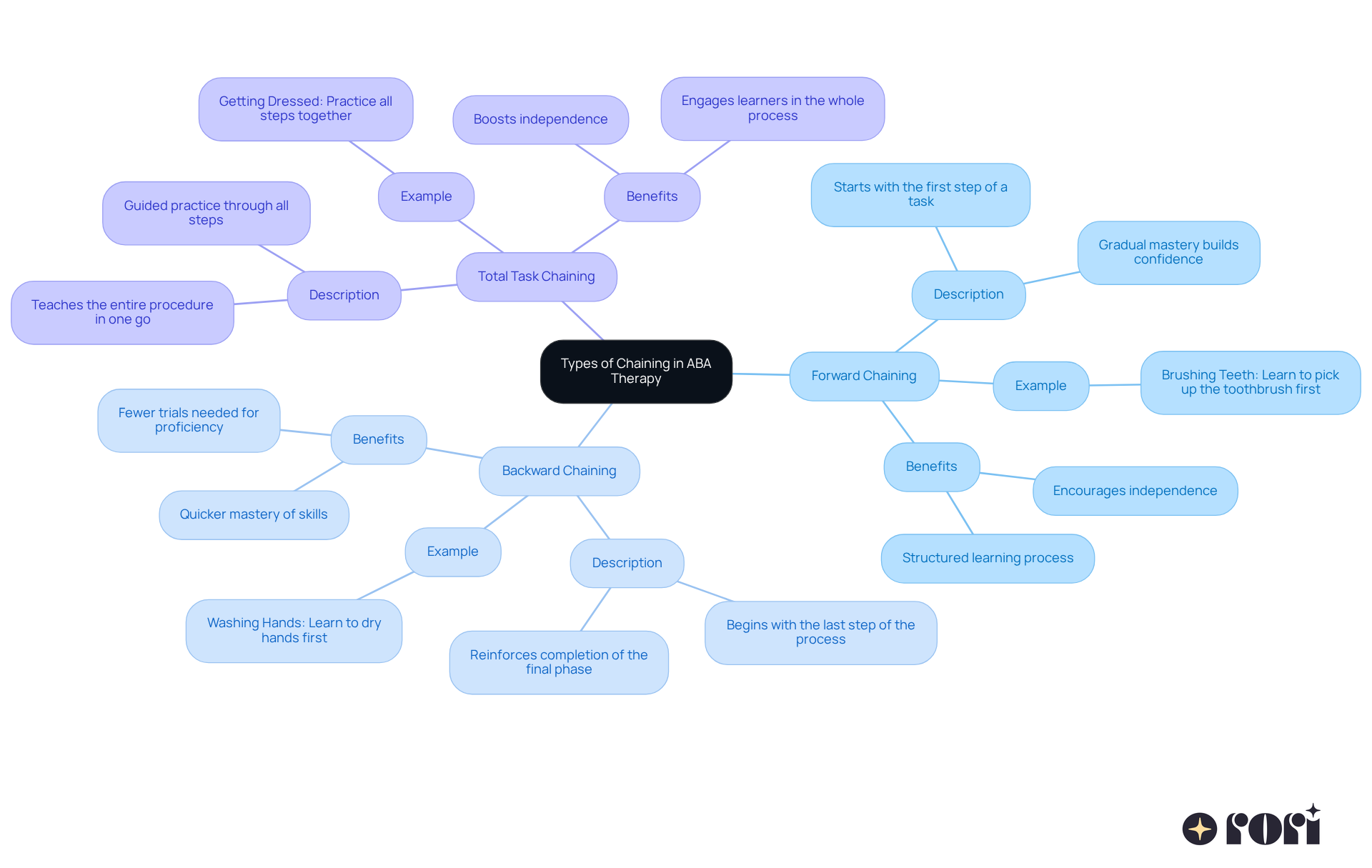Chaining in ABA therapy is a fantastic technique that helps break down complex behaviors into smaller, manageable steps. This approach makes learning a lot easier for children with autism! Not only does it enhance skill acquisition through structured learning and positive reinforcement, but it also builds independence and confidence as kids master each step of a task.
Imagine your child tackling a big challenge, one small step at a time. Each little victory boosts their confidence! It's such a rewarding journey to witness. So, if you're looking for ways to support your child's learning, consider exploring chaining in ABA therapy. We’re here to help you every step of the way! Let’s explore this together!
Chaining in Applied Behavior Analysis (ABA) therapy is such an important strategy for helping children with autism tackle complex tasks. By breaking these tasks down into smaller, more manageable steps, we make learning feel less overwhelming. This approach not only simplifies the process but also builds independence and confidence as each action is learned one step at a time.
But here's the thing: the effectiveness of chaining can really depend on how each child learns and the complexity of the tasks at hand. So, how can caregivers and therapists team up to make the most of these techniques for each child's unique needs? Let’s explore this together!
Chaining in ABA therapy is a wonderful method that helps kids learn complex behaviors by breaking them down into smaller, manageable steps. Each part of the process is taught one at a time, allowing children with autism to really get the hang of one action before moving on to the next. This approach makes learning easier by connecting simpler actions into a smooth behavior chain, which helps with both learning and remembering. For example, think about handwashing: the steps can be split into clear phases like turning on the faucet, wetting hands, applying soap, and rinsing. Each step gets a nice boost of positive feedback—like verbal praise or little rewards—which encourages kids to keep practicing and mastering the skill.
Qualified behavior analysts play a key role in this journey, crafting personalized plans that include measurable goals and evidence-based strategies tailored to each child’s unique needs. Research shows that chaining in ABA therapy methods can significantly improve skill acquisition and generalization, helping kids apply what they've learned in various situations. This tailored support, along with active involvement from caregivers, ensures that treatment plans are flexible and responsive to the child's progress. Importantly, ABA therapy is the only scientifically validated treatment for autism that is covered by insurance, making it an essential resource for fostering positive behavior changes and skill development across everyday activities, from getting dressed to tackling schoolwork.
Let’s explore this together! We’re here to help you every step of the way!

Chaining in ABA therapy is a fundamental technique focused on breaking tasks into manageable pieces. This approach works wonders for kids with autism, allowing therapists to create organized learning experiences that cater to each child's unique needs. 🌟 Research shows that personalized strategies in ABA therapy can really boost learning. In fact, studies have found that early and intensive interventions lead to better communication and cognitive skills.
When therapists use chaining in ABA therapy, they help kids master complex tasks step by step. This not only builds their skills but also nurtures a sense of confidence and independence as they tackle each part. Plus, it makes therapy sessions tailored to specific abilities and challenges, which leads to more effective learning and skill development.
And let’s not forget about caregiver training! When caregivers understand ABA principles and techniques, they can support their child's development at home much better. This knowledge empowers them to make informed choices and actively participate in their child's therapy journey. Together, we can create a supportive environment that contributes to positive behavioral outcomes. Let’s explore this together!

In ABA therapy, chaining in aba therapy includes three main types: forward chaining, backward chaining, and total process chaining. Each method offers unique benefits that cater to different learning styles and the complexity of tasks.
Forward Chaining: This approach starts with the first step of a task. Your little one learns to complete the initial task independently before moving on to the next. For example, when teaching a child to brush their teeth, they might first learn to pick up the toothbrush before applying toothpaste. This method allows for gradual mastery, building confidence as they learn each step in order.
Backward Chaining: Here, we begin with the last step of the process. Your child is guided through the entire task until they reach the final phase, which is then reinforced. This can be particularly motivating, as they get to experience that wonderful feeling of accomplishment right away! For instance, in washing hands, the child would first learn to dry their hands and then work backward through the steps. Research shows that backward chaining can lead to quicker mastery of skills, often requiring fewer trials to achieve proficiency compared to forward chaining.
Total Task Chaining: This technique involves teaching the entire procedure in one go. Your child is guided through every step, receiving help as needed. This method is especially useful for activities that involve multiple actions, like getting dressed, where they can practice all the steps together. Studies have shown that complete activity chaining can effectively boost independence, allowing your little learner to engage in the whole process in a single learning experience.
Each chaining method has its own strengths, and choosing the right one should depend on your child's learning style and the complexity of the task. Understanding these methods can empower parents and clinicians to select the most effective strategies for teaching daily living skills to individuals with autism. Let’s explore this together!

Chaining in ABA therapy can be a game-changer in real-life situations, especially for children with autism. They not only enhance the learning experience but also empower caregivers to support their development. Let’s dive into some examples:
Self-Care Routines: Think about teaching kids to wash their hands. By breaking it down into simple steps—like turning on the faucet, wetting their hands, applying soap, scrubbing, rinsing, and drying—they can learn to do it all by themselves! This fosters independence and helps caregivers reinforce these skills at home, creating a consistent learning environment.
Academic Skills: In the classroom, chaining can help students tackle multi-step math problems. Each part, from identifying the operation to performing calculations and writing the answer, can be taught one step at a time. Caregivers can use ABA principles to support their children’s academic growth in everyday situations—what a fantastic way to help them thrive!
Daily Living Abilities: Chaining in ABA therapy shines when it comes to teaching daily living skills, such as making a sandwich. Kids can learn to gather ingredients, spread condiments, add fillings, and assemble their creation step by step. This organized approach not only boosts their learning but also gives caregivers confidence in their ability to support their child’s educational journey.
These techniques, including chaining in ABA therapy, not only promote skill development but also nurture independence and self-confidence in children as they master complex tasks through structured learning. Plus, the involvement of caregivers is crucial in the ABA therapy process. Research shows that when caregivers are actively engaged, a whopping 90% of children show significant progress! This reinforces the patient-centered approach of ABA therapy, which is the only scientifically validated treatment for autism covered by insurance.
So, let’s explore this together and see how we can make a difference in our children’s lives!

Chaining in ABA therapy is a powerful technique; however, it does come with some challenges that we should consider together.
Individual Differences: Every child is unique, with their own learning styles and paces. This can really affect how they progress. For instance, some kids might need extra time to master each step, while others may zoom through quickly. This is why it's so important for therapists to be adaptable and tailor their approaches to fit each child's needs. A study even showed that children with autism significantly improved their handwashing skills when utilizing chaining in ABA therapy techniques. This highlights the importance of personalized strategies! Informed caregivers can use this knowledge to make choices that positively impact their child's learning at home.
Complexity of Activities: Sometimes, the complexity of certain activities can make chaining less effective. If an activity is too complicated, therapists might need to break it down or use additional strategies to help kids learn. For example, a case study found that using chaining in ABA therapy to teach all actions in a session can lead to quicker skill acquisition for simpler tasks. This helps kids grasp the whole sequence better. Empowered caregivers, who understand ABA principles, can support their children in mastering these tasks, reinforcing learning outside of therapy sessions.
Consistency and Reinforcement: Consistent reinforcement is key to the success of chaining techniques. Each step should be positively reinforced to motivate the child to progress through the chain. Research shows that positive reinforcement, like verbal praise or small rewards, boosts participation and encourages skill mastery. In practice, therapists can collect data on multiple opportunities to track progress and ensure effective reinforcement throughout the learning process. Caregiver involvement is crucial here, as they can provide consistent reinforcement at home, further supporting their child's development and enhancing family dynamics.
By understanding these challenges and adapting their strategies, therapists can make chaining in ABA therapy even more effective. This can lead to better outcomes for children with autism. The active involvement of informed and empowered caregivers can play a huge role in overcoming these challenges and achieving lasting behavioral improvements. Let’s explore this together!

Chaining in ABA therapy is such a valuable tool for teaching children with autism, breaking down complex tasks into manageable steps. This method not only makes learning easier but also builds independence and confidence as kids master each stage of a behavior. With tailored strategies, skilled behavior analysts create personalized plans that meet each child's unique needs, ensuring the learning process is both effective and enjoyable.
Throughout this article, we’ve explored various aspects of chaining, including:
Each method has its own advantages that can really enhance learning experiences, whether it’s for self-care routines, academic skills, or daily activities. We also highlighted the importance of caregiver involvement, showing how informed parents can reinforce skills at home, amplifying the benefits of ABA therapy.
Of course, there are challenges when it comes to implementing chaining techniques, like individual learning differences and task complexity. This is where adaptability and consistency in reinforcement strategies come into play. By understanding these challenges and actively participating in their child's therapy journey, caregivers can make a significant impact on their child's progress. Ultimately, chaining in ABA therapy equips children with essential skills while nurturing a supportive environment that fosters meaningful behavioral improvements and greater independence. Embracing these techniques can truly transform the lives of children with autism and their families. Let’s explore this together and see how we can make a difference!
What is chaining in ABA therapy?
Chaining in ABA therapy is a method that helps children learn complex behaviors by breaking them down into smaller, manageable steps. Each part of the process is taught one at a time, allowing children to master one action before moving on to the next.
How does chaining benefit children with autism?
Chaining makes learning easier by connecting simpler actions into a smooth behavior chain, which aids in both learning and remembering. It helps children with autism acquire skills more effectively and encourages confidence and independence.
Can you provide an example of chaining in practice?
An example of chaining is the handwashing process, which can be split into steps like turning on the faucet, wetting hands, applying soap, and rinsing. Each step is reinforced with positive feedback, such as verbal praise or small rewards.
Who is involved in implementing chaining during ABA therapy?
Qualified behavior analysts play a key role in implementing chaining by crafting personalized plans that include measurable goals and evidence-based strategies tailored to each child's unique needs.
What does research say about the effectiveness of chaining in ABA therapy?
Research shows that chaining methods in ABA therapy significantly improve skill acquisition and generalization, helping children apply what they've learned in various situations.
How does caregiver involvement impact the success of chaining in therapy?
Active involvement from caregivers ensures that treatment plans are flexible and responsive to the child's progress. When caregivers understand ABA principles, they can better support their child's development at home.
Is ABA therapy covered by insurance?
Yes, ABA therapy is the only scientifically validated treatment for autism that is covered by insurance, making it an essential resource for fostering positive behavior changes and skill development.